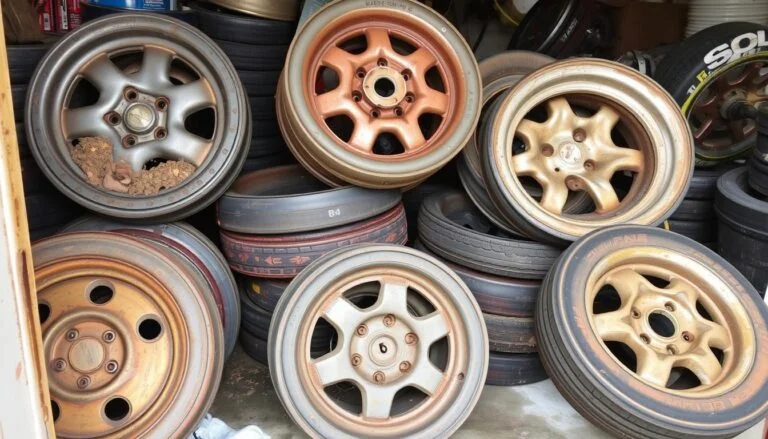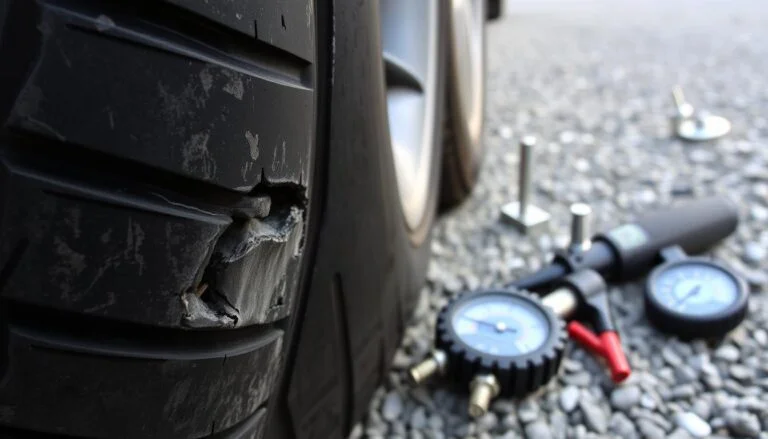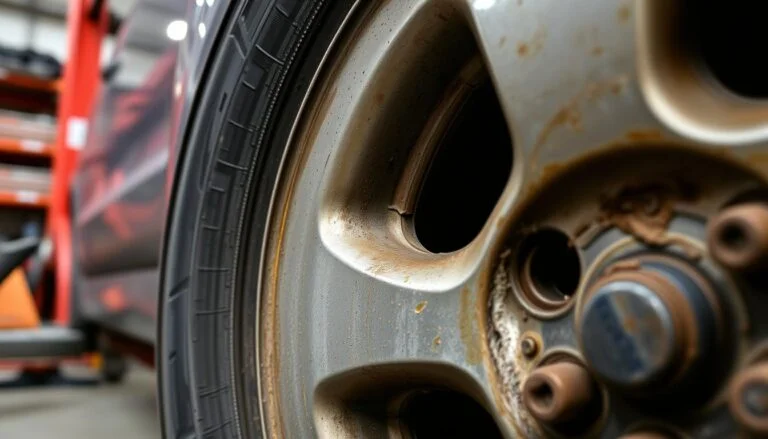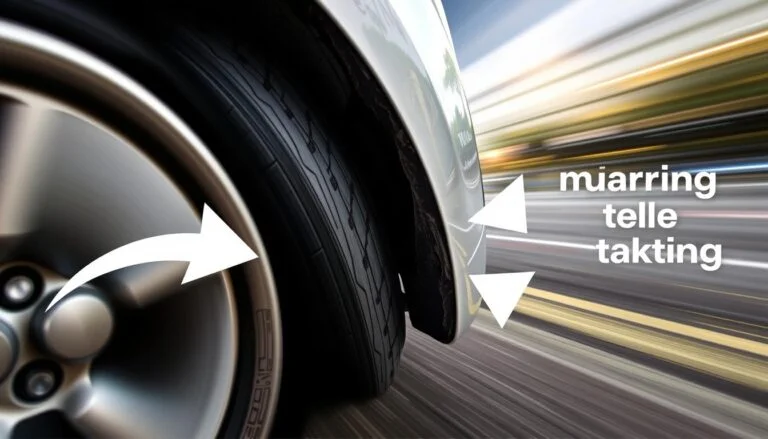What are the Safety Risks of Worn-Out Tires?
Tire condition is key to road safety. Worn-out tires can be dangerous, making it important to check and care for them. As tires get older, their tread wears down, reducing traction.
This can lead to poor vehicle handling and a higher risk of accidents. The loss of tread affects how well tires grip the road.
Statistics from the National Highway Traffic Safety Administration (NHTSA) and the American Automobile Association (AAA) show the danger of tire issues. We will explore the dangers of worn tires, discuss how to maintain them, and share tips for safe driving.

Key Takeaways
- Worn-out tires reduce traction, increasing the risk of skidding and accidents.
- Poor tire condition can lead to longer stopping distances.
- Regular tire maintenance is essential for safe driving conditions.
- Tire-related incidents are a common cause of accidents, according to the NHTSA and AAA.
- Degraded tire tread can significantly impact vehicle handling and safety.
Understanding Tire Wear Dangers
Driving on worn-out tires is dangerous. It affects how well your car handles and how safe it is. Knowing the risks of low tire tread is key.
Tire T tread Depth Hazards
Low tire tread can cause big problems. It leads to less grip on the road and a higher chance of hydroplaning. When tread is thin, tires can’t push water away, making it hard to stop on wet roads.
This makes driving much riskier. A study by Consumer Reports found that cars with thin tread take longer to stop, especially on wet roads.
Impact on Vehicle Handling
Tire tread depth is crucial for safe driving. As tread gets thinner, tires can’t grip the road as well. This makes steering and cornering harder, raising the chance of accidents.
It’s important to check your tires often. This ensures they’re safe and your car handles well.
| Tread Depth (inches) | Performance Impact | Recommended Action |
|---|---|---|
| 8/32″ – 10/32″ | Optimal Performance | Safe |
| 6/32″ – 7/32″ | Reduced Hydroplaning Resistance | Monitor Regularly |
| 4/32″ – 5/32″ | Increased Stopping Distance | Consider Replacement |
| 2/32″ or less | High Risk of Hydroplaning and Skidding | Replace Immediately |
Tire Blowout Risks on the Road
Tire blowouts are a big danger on the road. They can cause serious accidents. Knowing why they happen and how to react can make the roads safer.
Causes of Tire Blowouts
Several factors can lead to blowouts. Drivers can watch out for these:
- Overloading: Putting too much weight on a tire can cause it to blow out.
- Underinflation: Tires that are not properly inflated can overheat and fail.
- Tire Defects: Problems with the tire’s make or wear can also cause blowouts.
Immediate Actions During a Blowout
When a blowout happens, acting fast is key to stay safe:
- Keep a Firm Grip: Hold the steering wheel tightly to keep control.
- Avoid Braking: Don’t brake hard; instead, slow down by taking your foot off the gas.
- Steer Straight: Try to steer straight to fight the tire’s pull.
- Pull Over Safely: Once you’re in control, pull over to a safe spot.
According to the Federal Motor Carrier Safety Administration (FMCSA), tire failures are a top reason for accidents. By knowing about tire blowout risks and how to handle them, drivers can keep everyone safe.
The Importance of Regular Tire Maintenance
Keeping your tires safe and lasting long is all about tire maintenance importance. Regular checks can greatly lower the risk of tire wear and failure.
Doing preventative maintenance early on is key for your car’s best performance and safety. Let’s look at how to inspect your tires and spot tire replacement signs.
How to Inspect Your Tires
Regular tire inspection can show you many signs of wear. Here’s how to begin:
- Check the tread depth. Use a gauge or a penny. If you see Lincoln’s head, it’s time for new tires.
- Look for any damage, like cuts, punctures, or foreign objects. Bulges or blisters on the sidewall mean trouble.
- Keep an eye on tire pressure. The right pressure makes tires last longer and drive better.
Signs Your Tires Need Replacement
Knowing when to replace your tires is crucial for safety. Look out for these signs:
- Driving feels shaky, which could mean the tires are off balance or damaged.
- Uneven tread wear is a sign of alignment problems. It’s time for new tires.
- Worn tread strips away traction. This is a big problem when tread depth is less than 2/32 of an inch.
Regular tire maintenance boosts safety, saves money, and keeps your car running well.
Old Tire Safety Concerns
Tires get older and wear out, even if they’re not used a lot. It’s important to know the risks of old tires for road safety. We’ll look at how aging affects tires and how to find out their age.
The Effects of Aging Tires
As tires get older, their rubber loses its stretch and strength. This can cause them to grip the road less and be more likely to get punctures. The Rubber Manufacturers Association says old tires can be very dangerous, leading to serious accidents.
It’s key to understand how aging tires can affect your safety on the road.
How to Determine Tire Age
Finding out when a tire was made is easy if you know where to look. Each tire has a Department of Transportation (DOT) code on its sidewall. The last four digits tell you the week and year it was made.
For example, “2318” means it was made in the 23rd week of 2018. Checking the tire’s manufacturing date helps you know when to replace it. This keeps your tires safe and within a good lifespan.
Road Safety Tips to Prevent Accidents
Following road safety strategies makes the road safer for everyone. It also makes driving more enjoyable. Here are some key tips to avoid accidents:
- Always follow safe driving practices. This means sticking to speed limits, using your turn signals, and keeping a safe distance from other cars.
- Take care of your vehicle with regular checks. Make sure your oil levels, brake conditions, and headlights are all good.
- Keep an eye on your tire pressure and tread depth. Properly inflated and well-maintained tires help prevent accidents caused by blowouts and losing control.
- Stay alert and avoid distractions while driving. Focusing on the road helps you react fast to unexpected situations.
Adding these maintenance steps to your routine can make your car more reliable:
| Maintenance Task | Frequency | Benefit |
|---|---|---|
| Check Tire Pressure | Monthly | Improves fuel efficiency and tire longevity |
| Rotate Tires | Every 6,000 to 8,000 miles | Ensures even tire wear |
| Inspect Brakes | Every 20,000 miles | Enhances braking performance |
| Change Engine Oil | Every 3,000 to 5,000 miles | Maintains engine health |
What are the Safety Risks of Worn-Out Tires
Driving on worn-out tires is very dangerous. It can make your car perform poorly and increase the chance of accidents. It’s crucial to know the risks and take steps to avoid them.
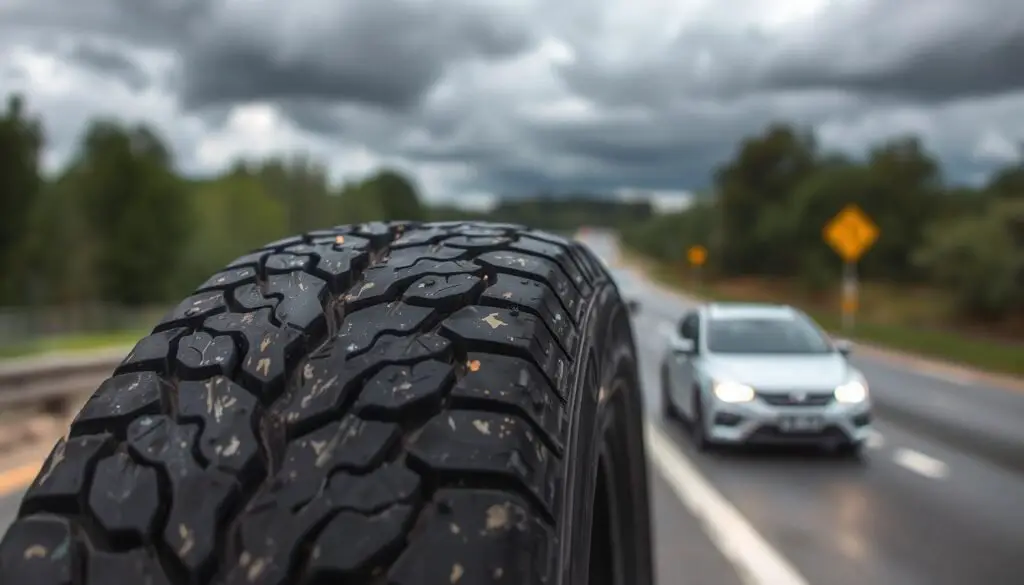
Reduced Traction and Skidding
Worn-out tires have less grip on the road. This is a big problem in bad weather like rain or snow. It makes it hard to stop the car and can cause accidents.
Increased Stopping Distances
Worn-out tires also make it harder to stop the car. They need more time and space to stop completely. This can be very dangerous in emergencies. The Insurance Institute for Highway Safety (IIHS) found that stopping distances get longer with worn tires. This shows why checking and replacing tires regularly is so important.
Preventing Tire Wear Accidents
Keeping your tires in good shape is key to avoiding tire wear and staying safe on the road. Regular tire rotation and correct tire inflation are essential steps.
Regular Tire Rotation
Following a regular tire rotation schedule is a smart move. The Car Care Council says to rotate tires every 6,000 to 8,000 miles. This spreads out wear evenly and makes your car handle better.
Doing this can save you money on new tires and prevent sudden blowouts. It’s a win-win for your wallet and your safety.
Proper Tire Inflation
Keeping your tires at the right pressure is also vital. If they’re not, you might see uneven wear, use more gas, and face a higher risk of accidents. Check your tire pressure monthly and before long drives.
Use a good pressure gauge to make sure your tires are just right. This keeps your car stable and helps prevent accidents. Keeping an eye on tire pressure is a big part of staying safe on the road.
- Check tire pressure monthly
- Rotate tires every 6,000 to 8,000 miles
- Use a reliable pressure gauge
By taking these steps, drivers can keep their tires in top shape. This leads to safer driving and fewer chances of accidents caused by tires.
Bald Tire Safety Concerns
Tire tread safety is key to road safety. Driving with bald tires is dangerous, leading to blowouts and losing control of the vehicle. As tires wear, they lose grip, causing accidents, especially on wet roads.

One major risk of bald tires is hydroplaning. Without enough tread, tires can’t push water away. This makes vehicles slide on water, risking serious accidents.
SafeCar.gov warns about the urgency of replacing worn tires. Waiting to replace smooth tires puts everyone at risk. It’s crucial to address bald tire risks quickly to avoid disasters.
| Risk | Consequence |
|---|---|
| Bald tires | Higher risk of blowouts |
| Smooth tires | Increased chance of hydroplaning |
| Worn tire | Poor vehicle handling |
The main point is clear: Tire tread safety and timely replacement of worn tires save lives. Always check your tires’ tread depth to stay safe on the roads.
Tire Inspection Recommendations
Regular tire checks are key for your car’s safety. By using a detailed tire inspection guide, you can spot problems early. This helps avoid accidents. Here, we’ll share important tips for checking your tires and how to use a tread depth gauge.
Visual Examination Tips
Begin by looking at your tires closely. Look for signs of uneven wear, like cupping or feathering, which might mean your car is not aligned right. Also, check for any damage, such as cuts, punctures, or bulges on the sidewall. Tires-Easy.com advises checking for hidden objects that could slowly leak air.
Regularly doing these checks can keep your tires in great shape.
Using a Tread Depth Gauge
To check if your tread is deep enough, use a tread depth gauge. This tool gives you a precise reading of your tire’s tread. Place the gauge in the grooves at different spots on the tire. TireRack says if it’s less than 2/32 of an inch, you need new tires.
By adding tread depth gauge checks to your routine, you make your car safer.
Regular self-checks are vital for keeping your car in good shape. Use these tips for checking tires and using a tread depth gauge. This way, you’ll keep your tires in excellent condition and drive safer.
FAQ
What are the safety risks of worn-out tires?
Worn-out tires can be very dangerous. They don’t grip the road well, making it hard to stop. This can lead to accidents, especially on wet or icy roads. Keeping your tires in good shape is key to staying safe on the road.
How does reduced tire tread depth affect driving safety?
Less tread means your tires can’t grip the road as well. This makes it easy to skid on wet surfaces. It also makes braking and turning harder. So, it’s important to keep your tread depth up for safe driving.
What are the common causes of tire blowouts?
Blowouts can happen for many reasons. These include underinflated tires, too much weight, and defects. Checking your tires often and keeping them in good shape can help avoid blowouts.
How should I respond if I experience a tire blowout while driving?
If you get a blowout, stay calm and hold the wheel tight. Slow down by easing off the gas and don’t slam on the brakes. Pull over safely and call for help if you need it.
What are the signs that indicate my tires need replacement?
Look for wear bars, cracks, bulges, or blisters on your tires. Also, if your tires vibrate, it’s time for new ones. These signs mean your tires are worn out and need to be replaced for your safety.
Why is regular tire maintenance important?
Keeping your tires in check is crucial for safety and performance. It makes your tires last longer, saves fuel, and improves how your car handles. Regular checks can prevent accidents and save you money.
How do aging tires affect safety?
Even unused tires can get worse over time. Heat, sunlight, and ozone can damage the rubber. This makes older tires more likely to crack, blow out, or lose grip.
How can I determine the age of my tires?
Check the Tire Identification Number (TIN) on your tire. The last four digits show the week and year it was made. For example, “2518” means it was made in the 25th week of 2018.
What road safety tips can help prevent tire wear accidents?
To avoid accidents, check your tire pressure often, rotate your tires, and avoid overloading. Also, look for any damage or wear on your tires. These steps help keep your tires in top shape and make the road safer.
How do worn-out tires affect stopping distances?
Worn tires make it harder to stop because they don’t grip the road well. This can cause you to stop too late, especially on wet roads. So, it’s important to keep your tread depth up for safe braking.
What are the benefits of regular tire rotation?
Rotating your tires evenly helps them wear down slower and improves how your car handles. It keeps traction balanced and prevents uneven wear. This makes driving smoother and safer.
Why is proper tire inflation important for safety?
The right tire pressure is key for safe driving. Under- or over-inflated tires can cause uneven wear, poor fuel efficiency, and a higher risk of blowouts. Regular checks keep your tires safe and your car running well.
What are the risks of driving on bald tires?
Bald tires are very dangerous. They can blow out, hydroplane, or cause you to lose control, especially in wet conditions. Replacing them quickly is essential for your safety.
How can I inspect my tires for wear and damage?
Check your tires for uneven wear, cracks, bulges, and any objects stuck in them. Use a tread depth gauge to measure tread depth. Regular checks help spot problems early.
How do I use a tread depth gauge to check my tires?
To use a tread depth gauge, insert it into the tread grooves and press down. Read the measurement to see how deep the tread is. Tires with less than 2/32 of an inch are too worn and need to be replaced.


